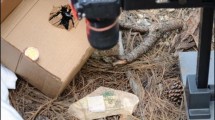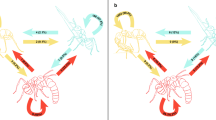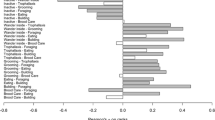Abstract
How social insect colonies behave results from the actions of their workers. Individual variation among workers in their response to various tasks is necessary for the division of labor within colonies. A worker may be active in only a subset of tasks (specialist), perform all tasks (elite), or exhibit no particular pattern of task activity (idiosyncratic). Here we examine how worker activity is distributed among and within tasks in ants of the genus Temnothorax. We found that workers exhibited elitism within a situation, i.e., in particular sets of tasks, such as those associated with emigrations, nest building, or foraging. However, there was weak specialization for working in a particular situation. A few workers exhibited elitism across all situations, i.e., high performance in all tasks in all situations. Within any particular task, the distribution of activity among workers was skewed, with few ants performing most of the work and most ants performing very little of the work. We further found that workers persisted in their task preference over days, with the same individuals performing most of the work day after day. Interestingly, colonies were robust to the removal of these highly active workers; they were replaced by other individuals that were previously less active. This replacement was not short-lived; when the removed individuals were returned to the colony, not all of them resumed their prior high activity levels, and not all the workers that replaced them reduced their activity. Thus, even though some workers specialize in tasks within a particular situation and are persistent in performing them, task allocation in a colony is plastic and colonies can withstand removal of highly active individuals.






Similar content being viewed by others
References
Akaike H (1974) A new look at the statistical model identification. IEEE Trans Autom Control 19:716–723
Aleksiev AS, Longdon B, Christmas MJ, Sendova-Franks AB, Franks NR (2008) Individual and collective choice: parallel prospecting and mining in ants. Naturwissenschaften 95:301–305
Beshers S (1999) Response thresholds and division of labor in insect colonies. In: Detrain C, Deneubourg JL, Pasteels JM (eds) Information processing in social insects. Birkhaeuser, Basel, pp 115–139
Beshers S, Fewell JH (2001) Models of division of labor in social insects. Annu Rev Entomol 46:413–440
Beshers SN, Traniello JFA (1996) Polyethism and the adaptiveness of worker size variation in the attine ant Trachymyrmex septentrionalis. J Insect Behav 9:61–83
Beverly BD, McLendon H, Nacu S, Holmes S, Gordon DM (2009) How site fidelity leads to individual differences in the foraging activity of harvester ants. Behav Ecol 20:633–638
Blanchard GB, Orledge GM, Reynolds SE, Franks NR (2000) Division of labour and seasonality in the ant Leptothorax albipennis: worker corpulence and its influence on behaviour. Anim Behav 59:723–738
Bonabeau E, Theraulaz G, Deneubourg JL (1996) Quantitative study of the fixed threshold model for the regulation of division of labour in insect societies. Proc R Soc Lond B 263:1565–1569
Bonabeau E, Theraulaz G, Deneubourg JL, Aron S, Camazine S (1997) Self-organization in social insects. Trend Ecol Evol 12:188–193
Breed MD, Williams DB, Queral A (2002) Demand for task performance and workforce replacement: undertakers in honeybee, Apis mellifera, colonies. J Insect Behav 15:319–329
Calderone NW (1995) Temporal division-of-labor in the honey-bee, Apis mellifera—a developmental process or the result of environmental influences. Can J Zool 73:1410–1416
Camargo RS, Forti LC, Lopes JFS, Andrade APP, Ottati ALT (2007) Age polyethism in the leaf-cutting ant Acromyrmex subterraneus brunneus Forel, 1911 (Hym., Formicidae). J Appl Entomol 131:139–145
Cao TT, Hyland KM, Malechuk A, Lewis LA, Schneider SS (2007) The influence of the vibration signal on worker interactions with the nest and nest mates in established and newly founded colonies of the honey bee, Apis mellifera. Insect Soc 54:144–149
Cassill DL, Tschinkel WR (1999) Task selection by workers of the fire ant Solenopsis invicta. Behav Ecol Sociobiol 45:301–310
Clauset A, Shalizi CR, Newman MEJ (2009) Power-law distributions in empirical data. SIAM Rev 51:661–703
Crosland MWJ, Traniello JFA, Scheffrahn RH (2004) Social organization in the drywood termite, Cryptotermes cavifrons: is there polyethism among instars? Ethol Ecol Evol 16:117–132
Donahoe K, Lewis LA, Schneider SS (2003) The role of the vibration signal in the house-hunting process of honey bee (Apis mellifera) swarms. Behav Ecol Sociobiol 54:593–600
Dornhaus A (2008) Specialization does not predict individual efficiency in an ant. PLoS Biol 6:2368–2375
Dornhaus A, Holley JA, Pook VG, Worswick G, Franks NR (2008) Why do not all workers work? Colony size and workload during emigrations in the ant Temnothorax albipennis. Behav Ecol Sociobiol 63:43–51
Dornhaus A, Holley JA, Franks NR (2009) Larger colonies do not have more specialized workers in the ant Temnothorax albipennis. Behav Ecol 20:922–929
Everitt B, Hothorn T (2011) An Introduction to applied multivariate analysis with R. Springer, New York
Franklin EL, Robinson EJH, Marshall JAR, Sendova-Franks AB, Franks NR (2011) Do ants need to be old and experienced to teach? J Exp Biol 215:1287–1292
Franks NR, Deneubourg JL (1997) Self-organizing nest construction in ants: individual worker behaviour and the nest’s dynamics. Anim Behav 54:779–796
Franks NR, Pratt SC, Mallon EB, Britton NF, Sumpter DJT (2002) Information flow, opinion polling and collective intelligence in house-hunting social insects. Phil Trans R Soc Lond B 357:1567–1583
Franks NR, Dornhaus A, Fitzsimmons J, Stevens M (2003) Speed vs. accuracy in collective decision-making. Proc Roy Soc B 270:2457–2463
Gardner KE, Foster RL, O’Donnell S (2007) Experimental analysis of worker division of labor in bumblebee nest thermoregulation (Bombus huntii, Hymenoptera: Apidae). Behav Ecol Sociobiol 61:783–792
Gautrais J, Theraulaz G, Deneubourg JL, Anderson C (2002) Emergent polyethism as a consequence of increased colony size in insect societies. J Theor Biol 215:363–373
Gordon DM (1984) The persistence of role in exterior workers of the harvester ant Pogonomyrmex-badius. Psyche 91:251–266
Gordon DM (1989) Dynamics of task switching in harvester ants. Anim Behav 38:194–204
Gordon DM (1996) The organization of work in social insect colonies. Nature 380:121–124
Gordon DM (2010) Ant encounters: interaction networks and colony behavior. Princeton University Press, Princeton
Gordon DM, Chu J, Lillie A, Tissot M, Pinter N (2005) Variation in the transition from inside to outside work in the red harvester ant Pogonomyrmex barbatus. Insect Soc 52:212–217
Hurd CR, Nordheim EV, Jeanne RL (2003) Elite workers and the colony-level pattern of labor division in the yellowjacket wasp, Vespula germanica. Behaviour 140:827–845
Hurd CR, Jeanne RL, Nordheim EV (2007) Temporal polyethism and worker specialization in the wasp, Vespula germanica. J Insec Sci 7, article no. 43
Inoue T, Salmah S, Sakagami SF (1996) Individual variation in worker polyethism of the Sumatran stingless bee, Trigona (Tetragonula) minangkabau (Apidae, Meliponinae). Jpn J Ent 64:641–668
Jaisson P, Fresneau D, Lachaud JP (1988) Individual traits of social behaviour in ants. In: Jeanne RL (ed) Interindividual behavioral variability in social insects. Westview, Boulder, pp 1–51
Jaisson P, Fresneau D, Taylor RW, Lenoir A (1992) Social organization in some primitive Australian ants Nothomyrmecia macrops Clark. Insect Soc 39:425–438
Jandt JM, Huang E, Dornhaus A (2009) Weak specialization of workers inside a bumble bee (Bombus impatiens) nest. Behav Ecol Sociobiol 63:1829–1836
Jeanson R, Fewell JH, Gorelick R, Bertram SM (2007) Emergence of increased division of labor as a function of group size. Behav Ecol Sociobiol 62:289–298
Julian GE, Cahan S (1999) Undertaking specialization in the desert leaf-cutter ant Acromyrmex versicolor. Anim Behav 58:437–442
Julian GE, Fewell JH (2004) Genetic variation and task specialization in the desert leaf-cutter ant, Acromyrmex versicolor. Anim Behav 68:1–8
Kolmes SA, Sommeijer MJ (1992) A quantitative analysis of behavioral specialization among worker stingless bees (Melipona-favosa) performing hive duties (Hymenoptera, Apidae). J Kansas Entomol Soc 65:421–430
Langridge EA, Sendova-Franks AB, Franks NR (2008) How experienced individuals contribute to an improvement in collective performance in ants. Behav Ecol Sociobiol 62:447–456
Le Conte Y, Hefetz A (2008) Primer pheromones in social Hymenoptera. Annual Rev Entomol 53:523–542
Moron D, Witek M, Woyciechowski M (2008) Division of labour among workers with different life expectancy in the ant Myrmica scabrinodis. Anim Behav 75:345–350
O’Donnell S (1998) Effects of experimental forager removals on division of labour in the primitively eusocial wasp Polistes instabilis (Hymenoptera: Vespidae). Behaviour 135:173–193
O’Donnell S (2006) Polybia wasp biting interactions recruit foragers following experimental worker removals. Anim Behav 71:709–715
O’Donnell S, Foster RL (2001) Thresholds of response in nest thermoregulation by worker bumble bees, Bombus bifarius nearcticus (Hymenoptera: Apidae). Ethology 107:387–399
Oster GF, Wilson EO (1978) Caste and ecology in the social insects. Princeton University Press, Princeton
Pearson B, Raybould AF, Clarke RT (1995) Breeding-behavior, relatedness and sex-investment ratios in Leptothorax-tuberum Fabricius. Entomologia Exp Et Appl 75:165–174
Pearson B, Raybould AF, Clarke RT (1997) Temporal changes in the relationship between observed and expected sex-investment frequencies, social structure and intraspecific parasitism in Leptothorax tuberum (Formicidae). Biol J Linn Soc 61:515–536
Pinter-Wollman N, Wollman R, Guetz A, Holmes S, Gordon DM (2011) The effect of individual variation on the structure and function of interaction networks in harvester ants. J Roy Soc Interface 8:1562–1573
Ravary F, Lecoutey E, Kaminski G, Chaline N, Jaisson P (2007) Individual experience alone can generate lasting division of labor in ants. Curr Biol 17:1308–1312
Retana J, Cerda X (1991) Behavioural variability and development of Cataglyphis-cursor ant workers Hymenoptera Formicidae. Ethology 89:275–286
Robinson GE (1987) Modulation of alarm pheromone perception in the honey bee: evidence for division of labor based on hormonally regulated response thresholds. J Comp Physiol A 160:613–619
Robinson GE (1992) Regulation of division of labor in insect societies. Ann Rev Entomol 37:637–665
Robinson GE, Huang ZY (1998) Colony integration in honey bees: genetic, endocrine and social control of division of labor. Apidologie 29:159–170
Robinson EJH, Feinerman O, Franks NR (2009) Flexible task allocation and the organization of work in ants. Proc Roy Soc B 276:4373–4380
Robinson EJH, Feinerman O, Franks NR (2012) Experience, corpulence and decision making in ant foraging. J Exp Biol 215:2653–2659
Robson SK, Traniello JFA (1999) Key individuals and the organization of labor in ants. In: Detrain C, Deneubourg JL, Pasteels JM (eds) Information processing in social insects. Birkhauser, Basel, pp 239–260
Robson SKA, Traniello JFA (2002) Transient division of labor and behavioral specialization in the ant Formica schaufussi. Naturwissenschaften 89:128–131
Rosengaus RB, Traniello JFA (1993) Temporal polyethism in incipient colonies of the primitive termite Zootermopsis angusticollis—a single multiage caste. J Insect Behav 6:237–252
Schafer RJ, Holmes S, Gordon DM (2006) Forager activation and food availability in harvester ants. Anim Behav 71:815–822
Schofield RMS, Emmett KD, Niedbala JC, Nesson MH (2011) Leaf-cutter ants with worn mandibles cut half as fast, spend twice the energy, and tend to carry instead of cut. Behav Ecol Sociobiol 65:969–982
Seid MA, Traniello JFA (2006) Age-related repertoire expansion and division of labor in Pheidole dentata (Hymenoptera: Formicidae): a new perspective on temporal polyethism and behavioral plasticity in ants. Behav Ecol Sociobiol 60:631–644
Sendova-Franks A, Franks NR (1993) Task allocation in ant colonies within variable environments (a study of temporal polyethism, experimental). Bull Math Biol 55:75–96
Sendova-Franks AB, Franks NR (1995a) Division of labor in a crisis—task allocation during colony emigration in the ant Leptothorax unifasciatus (Latr). Behav Ecol Sociobiol 36:269–282
Sendova-Franks AB, Franks NR (1995b) Spatial relationships within nests of the ant Leptothorax unifasciatus (Latr.) and their implications for the division of labour. Anim Behav 50:121–136
Smith A (1776) The wealth of nations. Methuen & Co., London
Theraulaz G, Bonabeau E, Deneubourg JL (1998) Response threshold reinforcement and division of labour in insect societies. Proc Roy Soc Lond B 265:327–332
Tofts C (1993) Algorithms for task allocation in ants—(a study of temporal polyethism theory). Bull Math Biol 55:891–918
Traniello JFA (1978) Caste in a primitive ant: absence of age polyethism in Amblyopone. Science 202:770–772
Trumbo ST, Huang ZY, Robinson GE (1997) Division of labor between undertaker specialists and other middle-aged workers in honey bee colonies. Behav Ecol Sociobiol 41:151–163
Visscher PK (1983) The honeybee way of death—necrophory behavior in Apis mellifera colonies. Anim Behav 31:1070–1076
Weidenmuller A (2004) The control of nest climate in bumblebee (Bombus terrestris) colonies: interindividual variability and self reinforcement in fanning response. Behav Ecol 15:120–128
Wilson EO (1980) Caste and division of labor in leaf-cutter ants: I. The overall pattern in Atta sexdens. Behav Ecol Sociobiol 7:143–156
Acknowledgments
The authors would like to thank members of the Social Insect Lab at the UA for feedback on the manuscript. We also thank the NSF (grants nos. IOS-1045239 and IOS-0841756 to AD), the DFG (Emmy Nöther fellowship to AD), and the BBSRC (grant E19832 to NRF) for funding.
Author information
Authors and Affiliations
Corresponding author
Additional information
Communicated by W. O. H. Hughes
Electronic supplementary material
Below is the link to the electronic supplementary material.
ESM 1
(PDF 574 kb)
Rights and permissions
About this article
Cite this article
Pinter-Wollman, N., Hubler, J., Holley, JA. et al. How is activity distributed among and within tasks in Temnothorax ants?. Behav Ecol Sociobiol 66, 1407–1420 (2012). https://doi.org/10.1007/s00265-012-1396-2
Received:
Revised:
Accepted:
Published:
Issue Date:
DOI: https://doi.org/10.1007/s00265-012-1396-2




